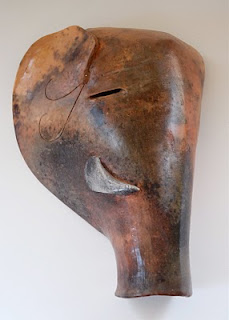A good friend of mine, Nick, visited me in Colorado in June, 2009. I was teaching an annual clay workshop in the Breckenridge Arts District called Fire It Up. Nick found pictures from that visit, and emailed them to me this week.
In a pit firing, like a raku firing, the process itself is a lot of fun. People often ask how pit firing is different from raku, where pots are also a fired at a lower temperature. One major difference between the two involves the timing of all the chemical reactions (ie, cool effects). With raku, chemical reactions are brought about once you remove the piece from the kiln, and with pit firing, all those reactions occur during the firing. Also, it's common to glaze pots for a raku firing, and for pit firing, the most I brush onto a pot is terra sigilata (a clay slip, aka 'terra sig') if I use anything at all. The effects of both firings are stunning, but very different.
Here I am working on an elephant mask (from that class in 2009). My friend Rachel is smoothing the bottom of her bird mask.
Texture is important to consider when building a piece for the pit because every indentation or smooth surface remains unchanged through the firing. There's no glaze to cover up a messy surface. For the elephant mask, I wanted a smooth, tranquil surface, and I brushed on a warm-hued terra sig to get muted colors. For the tusk, I used a white terra sig. White picks up a wide range of colors in the firing: yellows, reds, blues, greens, or grays and black.
I'm demonstrating for Nick that the elephant has its head turned to the side. One pit firing later, and voila! I think the mask turned out very well. I have it available for $60.



Wow! What a transformation. I am deeply moved by this mask.
ReplyDeleteHow beautiful. You have worked magic.
ReplyDelete